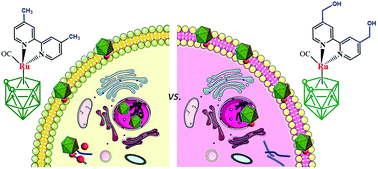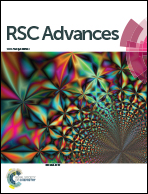Ruthenium carboranyl complexes with 2,2′-bipyridine derivatives for potential bimodal therapy application†
Abstract
Ruthenium complexes of carboranyl ligands offer the possibility of dual action (chemo + radiotherapy) that might result in significant clinical benefits. In that frame, we describe herein the development of ruthenium–carboranyl complexes bearing bipyridyl derivatives with the general formula [3-CO-3,3-{κ2-4,4′-R2-2,2′-bipy}-closo-3,1,2-RuC2B9H11] (R = CH3, RuCB1 or R = CH2OH, RuCB2). Both compounds crystallized in the monoclinic system, showing the expected three-legged piano stool structure. The ruthenacarboranes are stable in cell culture media and were tested against two cell lines that have shown favorable clinical responses with BNCT, namely melanoma (A375) and glioblastoma (U87). RuCB1 shows no cytotoxic activity up to 100 μM while RuCB2 showed moderate activity for both cell lines. Cell distribution assays showed that RuCB2 presents high boron internalization that is proportional to the concentration used indicating that RuCB2 presents features to be further studied as a potential anticancer bimodal agent (chemo + radiotherapy).



 Please wait while we load your content...
Please wait while we load your content...